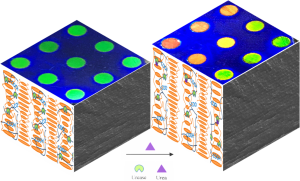Developing inexpensive and easy-to-use devices is important for many emerging technologies, especially for future biosensors.
Specifically, new sensing materials that enable simple visual detection need to be developed. Photonic crystals are an emerging material for such applications, because they can be used without batteries to detect analytes with color or intensity change.
Due to their ease of fabrication, cholesteric liquid crystals have received much attention for use as transducers for optical sensors. They possess a 1D photonic structure.
Towards this goal, researchers Kyung-Gyu Noh and Prof. Soo-Young Park from Kyungpook National University, develop a smart photonic structure using an interpenetrating polymer network system. The system comprises two intertwinned polymeric networks.
One of the polymer networks has a crosslinked photonic structure, while the other is a smart hydrogel that responds to an analyte. The hydrogel expands or shrinks in response to pH change that occurs because of an enzymatic reaction with an analyte, and induces simultaneous pitch and color changes in the intertwined photonic structure.
A biosensor arrays was fabricated using the duel-polymer system, and individual dots could be functionalized with an enzyme. The enzyme, urease, is commonly used as a study model for biosensor applications. The research demonstrated that the dots responded independently to urea by color change with high sensitivity and stability.
These patterned interpenetrated cholesteric liquid crystal/hydrogel polymer network in the form of a photonic array that can be used as a biosensor platform. The platform could provide a cost-effective and easy visual detection array without the need for sophisticated instruments.
The researchers state that, “These smart photonic array IPN structure fabricated with commercially available curable cholesteric liquid crystal materials and receptor-immobilized hydrogels can be deposited on flexible substrates (instead of glass substrates) to make patch-type (or tattoo-type) biosensors which can be further expanded to smart skin applications working without batteries.”

















